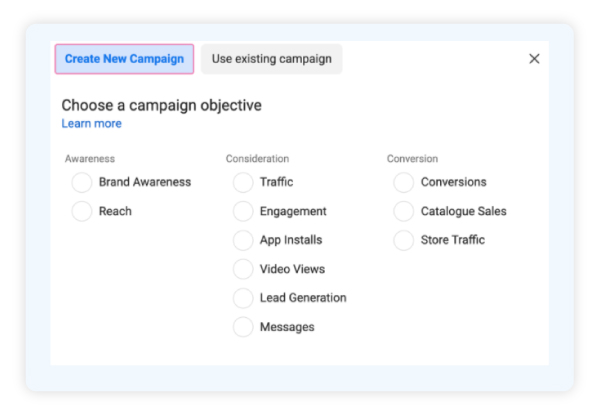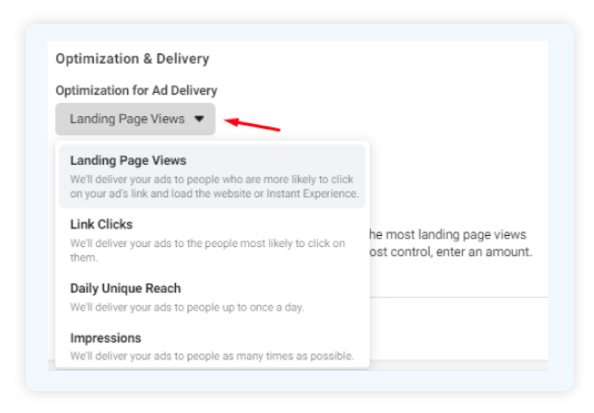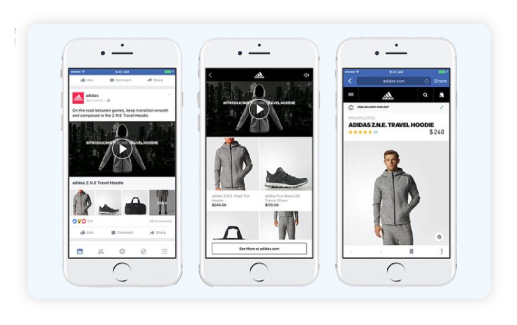[display-name-category]
[post_author]
We all like being told the rules before straying, but in PPC, there isn’t one for how much you should spend when it comes to Facebook ads. How much you invest depends on different factors, from geo-targeting location, campaign objectives to detailed targeting.
The budget that you will select for your Facebook ads will always vary depending on your objective since there are some campaigns that tackle the first part of the marketing funnel (such as Brand Awareness and Reach), where you are more likely to spend less than with campaigns in the deepest part of the funnel such as Conversions and Catalog Sales, which are more expensive.
That said, we are happy to help with some direction for you to begin. The steps below are based on our team’s experience. Following them can help you define a budget and determine how it can be useful.
Throughout your campaigns, you will learn to tweak your budget to find your sweet spot considering the factors mentioned above.
Define Your Marketing Budget
The first step is often the most practical. You need to assign your marketing budget. Whether it’s for conventional marketing or investing in PPC agency services, you need to find a number that works.
As a rule, a marketing budget for any business is around 5% – 12% of revenue. If your business is in its infancy, you should consider a more aggressive marketing approach.
The Importance of Investing in Facebook Ads
Why should you be spending money on Facebook anyway? It’s important to understand the benefits before moving forward.
Allocating a budget to Facebook Ads can cultivate brand awareness and test audiences.
- Brand Awareness: a key consideration for consumer behavior, this means potential clients are able to recall or recognize a brand under different conditions
- Testing Audiences: this helps you identify which audience converts better for your business. Thus, you will have to consider that when allocating your budget.
Develop a Strategy to Avoid Pitfalls
When determining a budget, a common mistake is allocating funds without a specific purpose or goal. Many business owners create or boost posts or a single ad once in a blue moon. In our saturated market, this usually causes little to no impact. Moreover, because it lacks a strategy, it’s usually not as targeted as one would think.
So, the question is, what do you want to achieve with your PPC marketing services? This question applies both to Google and Facebook.
With Facebook Ads, you can set your campaign’s objective from the get-go:

You’ll note that the image above separates objectives into three different columns. Each column represents different levels of the marketing funnel. Thus the cost per result per each of the campaign objectives will vary depending on the end goal.
What part of the funnel are you focused on?
Awareness
Do you want to start to build your community on Facebook?
Are you hoping to increase your brand awareness and reach?
Drive new users to your website?
If that’s the case, then you are focused on the top of the funnel: Awareness. You can start with a smaller budget than a Lead Generation, Conversions, Catalog Sales, or App Installs campaign.
Suppose you’re going to have a local target audience, such as some states, counties, or cities. In that case, you can spend between $200 – $800. You can allocate the budget either to one campaign or have different campaigns to have joint efforts.
For example, you can assign $200 for Engagement and $500 for Traffic in a local target audience such as Florida.
These parameters change if you aim for national scope. If that’s the case, we recommend a minimum of $1000 for Brand Awareness. Segment your ad sets per region or group of states. You can then identify which part of your campaign performs best and optimize based on the performing metrics.
Your cost per result will vary depending on optimization delivery. If you choose the “Link Clicks” result, your cost per result will always be lower since a “Link Click” is counted when someone opens your ad image or just clicks on any part of it. However, we need to take into consideration that link clicks won’t guarantee website traffic or conversions.
As a best practice, we always recommend for Traffic Campaigns, select “Landing Page Views” as your optimization delivery, since the “Landing Page Views” are people who actually visited your website and not only clicked on any side of your ad. With this optimization delivery that is more oriented to a Consideration part of the funnel, the Facebook algorithm will target people with the behavior of visiting similar websites, in contrast to Link Clicks, which is an optimization delivery associated with the first part of the marketing funnel.
You can select the configuration mentioned above at the ad set level.

Consideration
Moving to a deeper part of the funnel, we have the Consideration. These campaign’s objectives are different.
The main focus of this campaign is leading to a specific action such as downloading an app, filling out an instant form, or calling from the ad.
Naturally, these campaign types have a higher cost per result. In this section will be the Lead Generation and App Installs campaigns.
To target a local audience, start with $800 for Lead Generation, depending on the industry. Based on the accrue results, either increase your budget or test a different campaign that will complement your Facebook Ads strategy. When creating Lead Generation campaigns, you will have to consider if your potential customers are likely to either fill out a form on Facebook, for example, for a medical appointment or if it is more likely to call for it.
If you want to have a national scope, consider a budget of at least $1400. You can allocate this across ad sets, segmenting them by locations or A/B testing with diverse audiences based on interests, lookalikes based on people who have filled the form, or Facebook Engagement or page followers.
Conduct a thorough investigation of what’s the cost-per-result benchmark for your industry. Check if running Facebook ads will be profitable for your business or not. Click here to learn more about Facebook Ads benchmarks.
Conversion
Continuing down the funnel, we have Conversions.

These campaign types have a higher cost than the previous objectives since this leads to completing an action on the website. This type of conversation usually includes money, so the stakes are higher.
If you’re selling a low-dollar product or service, you will have to identify what’s the most you can spend while keeping your business profitable.
If your product is a high-dollar item, you have more wiggle room.
Keep this in mind when you create Conversions or Catalog Sales campaigns.
For a Conversions campaign, start with a minimum of $1000. Of course, this number varies depending on your product, industry, and scope (national vs. local).
Conclusion
The information above will help you determine a Facebook Ads budget for your business.
The first step is in understanding your numbers and goals. These elements will be influenced by industry and your business conversion value. The second thing to consider is the marketing funnel. Determine your objectives and purpose before assigning your budget.
Are you still struggling with the right budget for your Facebook Ads? Book a free consultation with one of our specialists!





